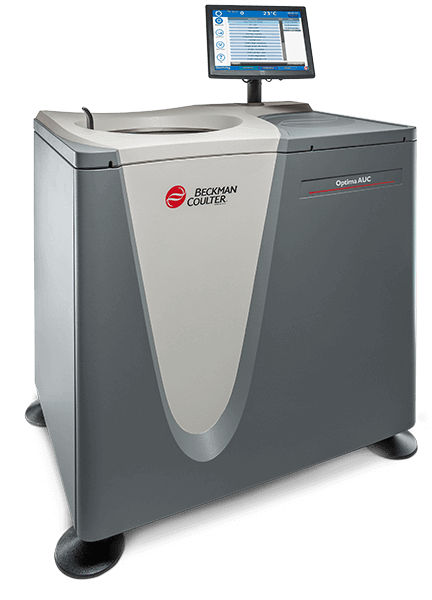세포 및 유전자 요법에는 신체에 치료제를 주입하기 위해 유전자 전달 용매를 사용합니다. 많은 유전자치료제 개발 회사들은 선택된 유전자 전달 매개체로 아데노 바이러스(AAV)를 이용하고 있습니다. 바이러스 캡시드는 치료 물질을 운반하기 위해 변형될 수 있으므로 AAV가 적합합니다. 연구자들은 먼저 바이러스 캡시드 중 손상되지 않은 비율을 확인해야 하며, 그 후 손상되지 않은 바이러스 캡시드 중 몇 개가 완충되어 있는지 파악해야 합니다. 이 유전자 이식 물질은 치료의 성공에 중요합니다.

전체 표적 치료 유전자를 포함하고 있지 않은 바이러스 입자들은 치료 활성을 생성할 가능성이 낮으며, 면역 반응과 같은 부작용을 일으킬 수 있습니다. 따라서, 연구자들은 이러한 입자들의 바이러스의 하중을 파악하는 것이 매우 중요합니다. 연구자들은 해당 바이러스 제제의 품질과 순도를 이해해야 하며, 다수는 분석형 초고속원심분리 (analytical ultracentrifugation)를 사용하고 있습니다.
rAAV 벡터 균질성, 순도(및 그 외) 측정용 용액: 용액 내 바이러스 입자를 분석합니다.
재조합 아데노 바이러스 벡터(rAAV)는 생명을 구할 수 있는 새로운 유전자 요법에 대한 밝은 전망이 있습니다.
그러나, 동적 광산란(dynamic light scattering, DLS) 또는 고성능 액체 크로마토그래피(high performance liquid chromatography, HPLC)와 같은 기존의 기법은 rAAV 비균질성 및 응집의 특성을 규명할 수 있기는 하지만 균질성 및 바이러스 입자의 채워짐 정도를 정량하기 위한 충분한 해상도를 제공하지 않습니다. 임상 등급 rAAV 벡터 제제의 생산을 준비할 시, 고해상도 측정이 하나의 장애물입니다.
유전자 치료 연구자들이 알고 있듯이, 초기 제품 개발에 많은 문제가 있는 상황에서는 빨리 실패하는 것이 기본입니다. 분석 초고속원심분리를 채택하면 다른 일반적인 기술과 달리 임상 등급 rAAV 벡터를 생산할 수 있습니다.
주요 장애물이란? 아래 나열된 항목과 관련하여 치료제 품질을 모니터링 할수 있는 고해상도 및 정량적 기술의 부족:
이상적인 해결책: 분석형 초고속원심분리(AUC) 를 통한 용액 내 분석.
Genethon의 과학자을 포함한 여러 과학자들은 혈청형(Serotype) 및 Transgene과는 관계없이 rAAV 벡터 의 준비상태를 Matrix-Free 분석으로 가능하다는 것을 발견하였고 , AUC는 다음에 도움이 됩니다.
- 바이러스 결합 상태 또는 균질성 확인
- 실험에 의한 응집 (Aggregation) 정량화
- 하위 입자 (Subparticle) 오염 확인
- Genetic payload를 정확하게 측정하기 위해 질량 정량화
Genethon의 Christine LE BEC와 그 팀이 균질성 및 바이러스 입자의 채워짐정도를 포함하여 scAAV 및 ssAAV 벡터를 성공적으로 특성화하기 위해 AUC를 어떻게 사용했는지 알아보려면 이 Webinar를 시청하십시오.
Analytical Methods to Measure Empty and Full AAV Particles
As gene therapy approaches usually require large amounts of AAV vectors for clinical use, few manufacturing processes have been reported to provide high titer and potent quantities of products.
The dose control of AAV vectors is commonly established on titration methods relying either on the quantitation of DNA (viral genome) or transgene expression following cell transduction (infectious genome). However, AAV vector lots are generally a heterogeneous mixture of empty particles (i.e. do not contain DNA) and full particles (i.e. contain DNA). Therefore, it could be considered that empty particles are product related impurities, which can impact on the immunogenicity profile of the product when high doses are administered to patients.
Different indirect methods can be used to establish the ratio between full and empty AAV particles. The quantification of full capsids is performed by using qPCR based technology. The total particles can be evaluated by an ELISA assay, spectrometric analysis, ion-exchange chromatography or SDS-PAGE. However, these methods have limitations and are not applicable to all serotypes without performing a new development.
Using analytical ultracentrifugation approach, we have developed a method to quantify simultaneously empty and full AAV particles as well as intermediate species containing fragmented or incomplete vector genome. We have applied this technique to AAV lots of different serotypes, several sizes of transgene and different process of production. Several examples of AAV vectors analysis will be presented showing that AUC could be implemented as a routine test to monitor AAV product quality and manufacturing consistency.



